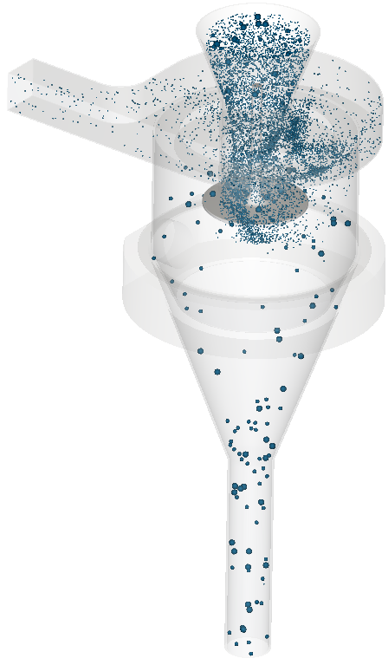Why should you perform a classification process?
Classifiers exist in a wide variety of designs. Depending on the material to be classified or the bulk material fractions intended after the classification process, not only the type of classifier but also the selection of the process parameters is always of decisive importance.
Among other things, the quantity of bulk material fed and the prevailing pressure conditions are particularly relevant here. The pressures used to operate the classifier and the resulting flow conditions are decisive for the quality of the classification. The exclusive consideration of the gas or fluid flow alone is not sufficient, since there are strong interactions with the bulk material.
Previous simulation methods, primarily based on flow simulations using CFD or SPH, can only partially represent these effects and the information about the real mechanisms in the classifier is limited. However, coupling the Discrete Element Method (DEM) with CFD or SPH offers the possibility to map the real interactions and thus generate an in-depth understanding.
CFD: Computational Fluid Dynamics
SPH: Smoothed Particle Hydrodynamics

Simulation of an air classifier
What are the benefits?
In contrast to the trial-based adjustment of process parameters, the experience-based or purely flow simulation-based design of machines, the discrete element simulation offers the following advantages:
- Process simulation taking into account real interactions between flow and bulk material
- Digital determination of pressure ratios, max. mass flows and visual quality
- Design optimization without complex prototype construction
- process understanding without complex measurement technology
- no consumption of material
- Process knowledge is built up with each additional simulation
- independent of scheduling limitiations
By using simulation, costs for materials, for the implementation of machines as well as for the test operation can be saved, personnel and energy expenses can be significantly reduced and machine downtimes can be kept to a minimum.
What is the simulation capable of?
The simulation of classifying processes enables the analysis of the movement behavior of the individual bulk material fraction in the machine, e.g. in order to identify critical areas with particle accumulation and to derive changes in the design or process parameters.
Particularly in classifying processes with strongly turbulent flows, collisions between particles can occur, which in turn can lead to breakage and thus to a reduction in particle size. Grinding processes can therefore occur. Depending on the bulk material used, this must be avoided in some cases, e.g. in order to maintain particle geometries generated in a defined manner in the pre-process.
It is therefore possible to identify areas where collisions occur between the particles and also to map the breakage behavior.
Stream lines of the bulk material fractions
Volumetric loading of an air classifier
By analyzing the volumetric loading of the bulk material inlet area as well as the two outlet areas, the volumetric loading of the classifier can be determined.
Depending on the particle size distribution and the bulk material fractions which need to be classified, it can be ensured even before starting up the machine that the volumetric utilization of the classifier does not exceed locally defined limit values and that operational reliability is guaranteed.
Conclusion
The simulation of classification processes with a coupling of discrete element simulations and classical flow simulations thus allows extensive analyses to be carried out, which make it possible to understand the process faster and more comprehensively in comparison to what was previously possible with classical trial- based, experience-based or only fluid flow-based approaches. In addition to what is shown here, countless other possibilities exist.
Do you have any questions?
Please contact us via the contact form or E-Mail.

